Nasal Function
The important functions of the nose are to humidify, warm and filter inspired air before it reaches the lungs. Whether the ambient temperature is 100 °F in the shade or -40 °F below freezing, and regardless of the prevailing relative humidity, the air that eventually reaches the lungs will be near body temperature, close to 98% humidity and will have been filtered clean of most particulate and chemical pollutants.
Nasal Mucosa
The nose is covered by a complex mucous membrane. The active surface of this membrane, on which the important functions of the nose take place, is greatly expanded by the irregular anatomy of the nasal walls (turbinates, meatuses, septum, etc.)
The mucosa has a very rich blood supply which brings it heat and the energy needed to perform its functions.
Included in the respiratory epithelium are a variety of active cells. Serous glands produce and deliver to the surface a watery secretion rich in proteins which, among other things, have anti-infective properties. Mucous glands and goblet cells produce a slimy, semi-sticky liquid which provides lubrication and entraps particulate and chemical pollutants. So-called pseudo-columnar epithelial cells have cillia on their surface. Cillia are fine microscopic hairs which, moving in a wave-like formation known as the"cilia-beat," move the above-mentioned mucous blanket out of the sinuses and into the nasal cavity, backwards out of the nose into the nasal pharynx and ultimately past the larynx, into the esophagus and down into the stomach. In the GI tract the mucus and all it contains is digested, neutralized, recycled and/or eliminated. On a normal day the nasal glands produce a very significant amount of mucus.
Dryness deactivates ciliary transport. It results in sticky, hardened mucus, accompanied by crusting, cracked, irritated membranes, bloody discharges, scabbiness, post-nasal dripping, etc. These are discomforts with which many people contend on a regular basis, especially during cold, dry winter months.
A dry nasal mucosa which has lost its ability to perform its air-conditioning functions can be harmful to the lungs.
The passage of mucus down the throat is ordinarily a perfectly normal function. The glands of the upper respiratory tract produce a constant flow of it. When this mucus is thin, it passes without notice. However, when it is dry and excessively sticky, it produces the unpleasant feeling commonly known as "POST NASAL DRIP."
A dry nasal lining (mucosa) is usually characterized by inflamed, dry, crusty, nasal passages and may result from a variety of causes, including:
- Air-born particulates and chemical pollutants.
- Low-humidity (arid) environments, whether natural or a consequence of indoor heating; air-conditioning.
- Extended airplane travel or habitation at elevated altitudes. The use of certain nasal inhalants (particularly steroids) for anti- allergen therapy.
- The use of certain inhalants, e.g. oil-based nasal steroid sprays such as ACCUTANE which is used for acne therapy.
- During and after a cold or sinus infection.
- Equipment used to treat snoring and sleep apnea.
- The use of oxygen therapy, especially when introduced through nasal prongs.
- A natural consequence of aging
- Following nasal surgery (consult your physician before using).
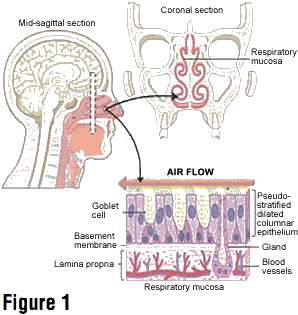
This figure [Figure 1] shows lateral and coronal views of the nose and illustrates the enhanced surface area on which important functions of the mucosa take place. Also shown is a simplified version of the lining membrane's components.
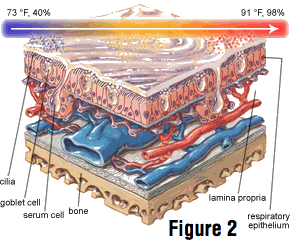
This figure [Figure 2] shows in greater detail the bones of the nose, the sub-mucosal layer which contains a rich blood and nerve supply, and respiratory epithelium which contain the various active cells. Atop all of this is the so-called mucous blanket and the cilia which propel it to its destiny. The arrows on top illustrate cool, dry air moving across the surface and being warmed and humidified. The various colored dots represent pollutants being removed from the inspired air.
NōzAmi provides proven relief from the discomforts of dry nasal passages
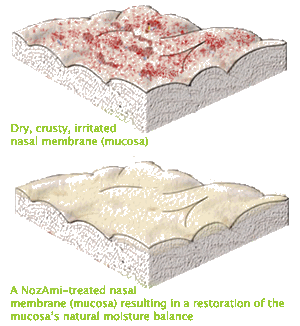
Origin of Sesame Oil's Therapeutic Effects
The nose's natural transport mechanism distributes a thin film of Sesame oil with its natural antibacterial, antifungal, antiviral and anti- inflammatory components (Vitamin E, Sesaminol and Sesamolinol) throughout the nasal cavity. Although the full therapeutic effect is generally achieved in 4-7 days (see below), an initial level of soothing relief from dry, crusty, irritated mucosa can be felt almost immediately. Daily use over a period of 7-14 days permits the natural moisture balance of your nasal cavity to re-establish itself, resulting in a level of relief from nasal discomfort that is typically 3-4 times greater than that experienced by using isotonic saline sprays during the same period (see below). Once a level of comfort has been restored (approx. 2 weeks) continued use of NōzAmi on an as-needed-basis will offer continued relief from the discomforts associated with dry, stuffy nasal passages.
NōzAmi vs Saline Sprays/Solutions
In recent years, an increasing number of individuals suffering from the dry, crusty, irritating discomforts associated with dry nasal passages have sought relief through the use of isotonic saline sprays or gels. It would be informative, therefore, to consider the comparative effectiveness of Sesame oil and isotonic saline sprays in this regard. To this end, a team of medical researchers performed a series of clinical studies designed to address just this issue. Their results (see below) demonstrate that Sesame oil provides a level of relief from the discomforts associated with dry nasal passages that is typically 3-4 times greater than that obtained with saline sprays.
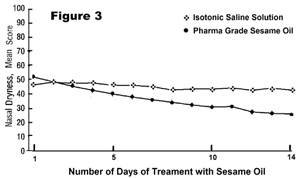
Nasal Dryness
The results of the first study demonstrate that the level of nasal passage dryness in individuals using Sesame oil is decreased by 45% over a 14-day period, while those using an isotonic saline solution or spray reported a reduction in discomfort of only 13% over the same period.

Nasal Stuffiness
A second study was conducted by these same researchers to establish the comparative effectiveness of Sesame oil and an isotonic saline spray at relieving the level of discomfort in individuals afflicted with nasal stuffiness. The results reveal that Sesame oil typically affords a 42% reduction in nasal stuffiness over a 14-day period, while the isotonic spray produced only a 7% reduction over the same period of time.
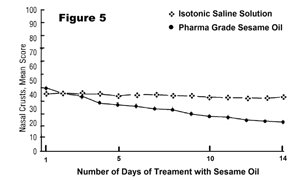
Nasal Crusts
Finally, in a third study, these same researchers found that the level of discomfort caused by nasal crusting was diminished by 52% in individuals using Sesame oil over a 14-day period, while those using an isotonic saline solution or spray recorded a reduction of only 5% over the same period.

